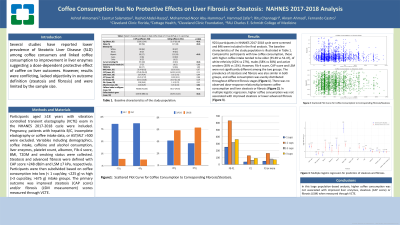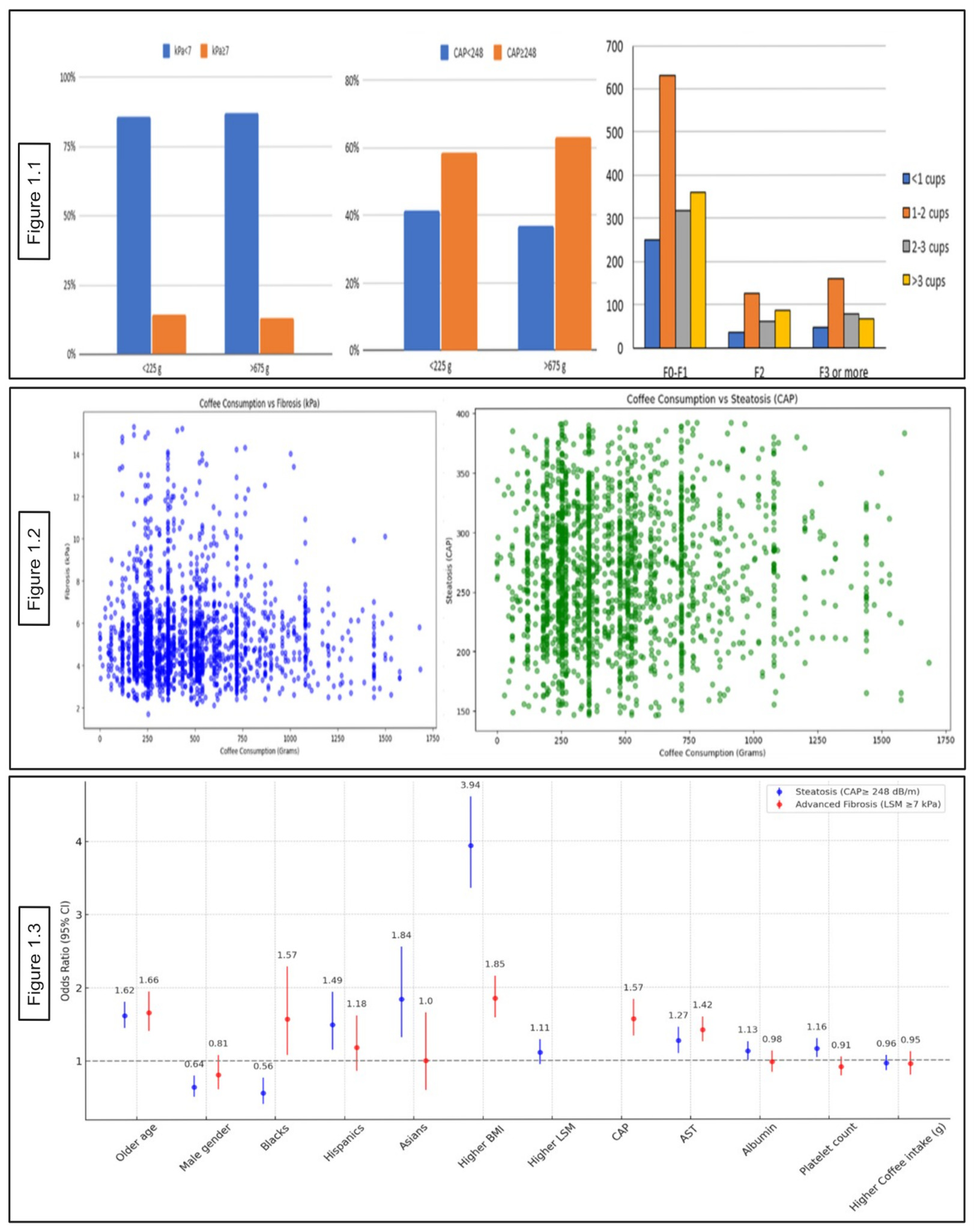Tuesday Poster Session
Category: Liver
P4643 - Coffee Consumption Has No Protective Effects on Liver Fibrosis or Steatosis: NHANES 2017-2018 Analysis
Tuesday, October 29, 2024
10:30 AM - 4:00 PM ET
Location: Exhibit Hall E

Has Audio

Ashraf Momani, MD
Cleveland Clinic Florida
Weston, FL
Presenting Author(s)
Ashraf Almomani, MD1, Esentur Salamatov, MD2, Rashid Abdel-Razeq, MD3, Mohamad-Noor Abu-Hammour, MD4, Hammad Zafar, MD1, Pravallika NA. Chadalavada, MD1, Akram Ahmad, MD1, Fernando NA. Castro, MD1
1Cleveland Clinic Florida, Weston, FL; 2Santa Barbara Cottage Hospital, Santa Barbara, CA; 3Cleveland Clinic, Cleveland, OH; 4Cleveland Clinic Fairview, Cleveland, OH
Introduction: Several studies have reported lower prevalence of Steatotic Liver Disease (SLD) among coffee consumers and linked coffee consumption to improvement in liver enzymes suggesting a dose-dependent protective effect of coffee on liver outcomes. However, results were conflicting, lacked objectivity in outcome definition (steatosis and fibrosis) and were limited by the sample size.
Methods: Participants aged ≥18 years with vibration controlled transient elastography (VCTE) exam in the NHANES 2017-2018 cycle were included. Pregnancy, patients with hepatitis B/C, incomplete elastography or coffee intake data, or AST/ALT >500 were excluded. Variables including demographics, coffee intake, caffeine and alcohol consumption, liver enzymes, platelet count, albumen, Fib-4 score, BMI, T2DM and smoking status were collected. Steatosis and advanced fibrosis were defined with CAP score >248 dB/m and LSM ≥7 kPa, respectively. Participants were then subdivided based on coffee consumption into low (< 1 cup/day; < 225 g) vs high (≥ 3 cups/day; >675 g) intake groups. The primary outcome was improved steatosis (CAP score) and/or fibrosis (LSM measurement) scores measured through VCTE.
Results: 9254 participants in NHANES 2017-2018 cycle were screened and 846 were included in the final analysis. The baseline characteristics of the study population is illustrated in Table 1. Compared to participants with low coffee consumption, those with higher coffee intake tended to be older (55.69 vs 52.47), of white ethnicity (62% vs 27%), males (58% vs 38%) and active smokers (30% vs 13%). However, Fib-4 score, CAP score and LSM were not significantly different among the two groups. The prevalence of steatosis and fibrosis was also similar in both groups, and coffee consumption was evenly distributed throughout different fibrosis stages (Figure 1.1). There was no observed dose-response relationship between coffee consumption and liver steatosis or fibrosis (Figure 1.2). In multiple logistic regression, higher coffee consumption was not associated with improved steatosis or lower advanced fibrosis (Figure 1.3).
Discussion: In this large population-based analysis, higher coffee consumption was not associated with improved liver enzymes, steatosis (CAP score) or fibrosis (LSM) outcomes when measured through VCTE.

Note: The table for this abstract can be viewed in the ePoster Gallery section of the ACG 2024 ePoster Site or in The American Journal of Gastroenterology's abstract supplement issue, both of which will be available starting October 27, 2024.
Disclosures:
Ashraf Almomani, MD1, Esentur Salamatov, MD2, Rashid Abdel-Razeq, MD3, Mohamad-Noor Abu-Hammour, MD4, Hammad Zafar, MD1, Pravallika NA. Chadalavada, MD1, Akram Ahmad, MD1, Fernando NA. Castro, MD1. P4643 - Coffee Consumption Has No Protective Effects on Liver Fibrosis or Steatosis: NHANES 2017-2018 Analysis, ACG 2024 Annual Scientific Meeting Abstracts. Philadelphia, PA: American College of Gastroenterology.
1Cleveland Clinic Florida, Weston, FL; 2Santa Barbara Cottage Hospital, Santa Barbara, CA; 3Cleveland Clinic, Cleveland, OH; 4Cleveland Clinic Fairview, Cleveland, OH
Introduction: Several studies have reported lower prevalence of Steatotic Liver Disease (SLD) among coffee consumers and linked coffee consumption to improvement in liver enzymes suggesting a dose-dependent protective effect of coffee on liver outcomes. However, results were conflicting, lacked objectivity in outcome definition (steatosis and fibrosis) and were limited by the sample size.
Methods: Participants aged ≥18 years with vibration controlled transient elastography (VCTE) exam in the NHANES 2017-2018 cycle were included. Pregnancy, patients with hepatitis B/C, incomplete elastography or coffee intake data, or AST/ALT >500 were excluded. Variables including demographics, coffee intake, caffeine and alcohol consumption, liver enzymes, platelet count, albumen, Fib-4 score, BMI, T2DM and smoking status were collected. Steatosis and advanced fibrosis were defined with CAP score >248 dB/m and LSM ≥7 kPa, respectively. Participants were then subdivided based on coffee consumption into low (< 1 cup/day; < 225 g) vs high (≥ 3 cups/day; >675 g) intake groups. The primary outcome was improved steatosis (CAP score) and/or fibrosis (LSM measurement) scores measured through VCTE.
Results: 9254 participants in NHANES 2017-2018 cycle were screened and 846 were included in the final analysis. The baseline characteristics of the study population is illustrated in Table 1. Compared to participants with low coffee consumption, those with higher coffee intake tended to be older (55.69 vs 52.47), of white ethnicity (62% vs 27%), males (58% vs 38%) and active smokers (30% vs 13%). However, Fib-4 score, CAP score and LSM were not significantly different among the two groups. The prevalence of steatosis and fibrosis was also similar in both groups, and coffee consumption was evenly distributed throughout different fibrosis stages (Figure 1.1). There was no observed dose-response relationship between coffee consumption and liver steatosis or fibrosis (Figure 1.2). In multiple logistic regression, higher coffee consumption was not associated with improved steatosis or lower advanced fibrosis (Figure 1.3).
Discussion: In this large population-based analysis, higher coffee consumption was not associated with improved liver enzymes, steatosis (CAP score) or fibrosis (LSM) outcomes when measured through VCTE.

Figure: Figure 1.1: The prevalence of steatosis and fibrosis in the study population (left) with fibrosis stage distribution among coffee drinkers (right). Figure 1.2: Scattered plot of the relationship between coffee consumption with fibrosis (left) and steatosis (right). Figure 1.3: Forest plot for multiple logistic regression for predictors of steatosis and fibrosis.
Note: The table for this abstract can be viewed in the ePoster Gallery section of the ACG 2024 ePoster Site or in The American Journal of Gastroenterology's abstract supplement issue, both of which will be available starting October 27, 2024.
Disclosures:
Ashraf Almomani indicated no relevant financial relationships.
Esentur Salamatov indicated no relevant financial relationships.
Rashid Abdel-Razeq indicated no relevant financial relationships.
Mohamad-Noor Abu-Hammour indicated no relevant financial relationships.
Hammad Zafar indicated no relevant financial relationships.
Pravallika Chadalavada indicated no relevant financial relationships.
Akram Ahmad indicated no relevant financial relationships.
Fernando Castro indicated no relevant financial relationships.
Ashraf Almomani, MD1, Esentur Salamatov, MD2, Rashid Abdel-Razeq, MD3, Mohamad-Noor Abu-Hammour, MD4, Hammad Zafar, MD1, Pravallika NA. Chadalavada, MD1, Akram Ahmad, MD1, Fernando NA. Castro, MD1. P4643 - Coffee Consumption Has No Protective Effects on Liver Fibrosis or Steatosis: NHANES 2017-2018 Analysis, ACG 2024 Annual Scientific Meeting Abstracts. Philadelphia, PA: American College of Gastroenterology.
